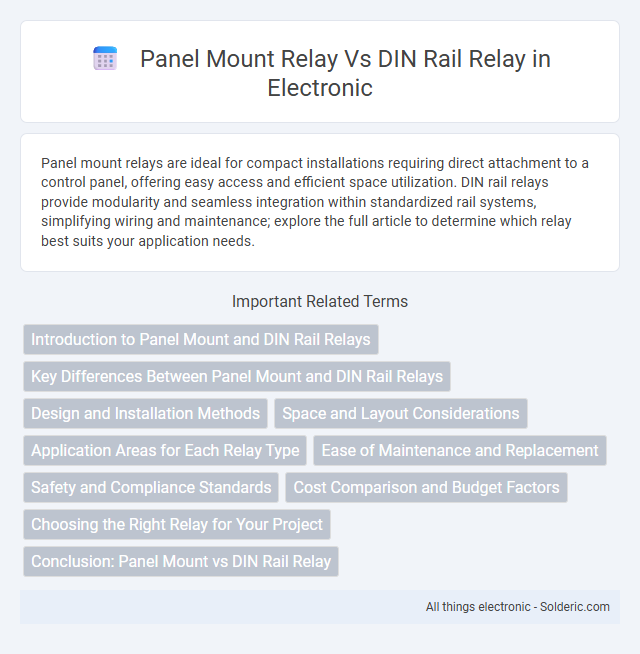Panel mount relays are ideal for compact installations requiring direct attachment to a control panel, offering easy access and efficient space utilization. DIN rail relays provide modularity and seamless integration within standardized rail systems, simplifying wiring and maintenance; explore the full article to determine which relay best suits your application needs.
Comparison Table
| Feature | Panel Mount Relay | DIN Rail Relay |
|---|---|---|
| Mounting | Directly onto a panel or enclosure surface | Mounted on standardized DIN rails inside control panels |
| Installation | Requires drilling and securing screws | Snap-on installation, easy removal and replacement |
| Space Efficiency | Less compact, requires panel space | Optimized for compact control cabinets |
| Wiring | Terminal screws or soldered connections | Plug-in or screw terminals, streamlined wiring |
| Typical Applications | Industrial panels, control desks | Automation control, switchgear, distribution boards |
| Maintenance | Manual removal from panel, more time-consuming | Quick replacement due to modular design |
| Standards | Varied depending on panel design | Complies with DIN EN 60715 mounting standards |
Introduction to Panel Mount and DIN Rail Relays
Panel mount relays are electrical devices designed to be securely installed on control panels, offering compact and accessible switching solutions for automation and control systems. DIN rail relays are specifically engineered to snap onto standardized DIN rails within electrical enclosures, facilitating modularity and ease of maintenance in industrial and commercial installations. Both relay types provide reliable switching functions but differ in mounting methods, space requirements, and application flexibility.
Key Differences Between Panel Mount and DIN Rail Relays
Panel mount relays are designed for installation directly onto control panels, offering compact size for space-constrained applications, while DIN rail relays are engineered to snap onto standardized DIN rails in electrical enclosures, allowing for easier modular installation and maintenance. Panel mount relays typically provide more robust environmental protection with sealed housings, whereas DIN rail relays emphasize flexibility and scalability in industrial automation systems. The key differences revolve around mounting method, space optimization, and integration convenience within control systems.
Design and Installation Methods
Panel mount relays are designed for direct attachment to control panels, using screw terminals or socket bases for secure installation, offering compactness and ease of wiring in confined spaces. DIN rail relays feature a modular design with standardized clips that snap onto a 35mm DIN rail, facilitating quick installation and removal in industrial automation setups. Your choice depends on the enclosure layout and maintenance preferences, as panel mount relays suit fixed, permanent setups while DIN rail relays provide flexible system integration and streamlined wiring in control cabinets.
Space and Layout Considerations
Panel mount relays require minimal space and can be directly installed on control panels, offering a compact and organized layout ideal for limited areas. DIN rail relays provide flexibility for modular installations and efficient wiring in industrial enclosures, optimizing space through standardized rail mounting. Your choice impacts installation density and ease of maintenance, with panel mount relays suited for smaller, precise setups and DIN rail relays benefiting larger, complex systems.
Application Areas for Each Relay Type
Panel mount relays are primarily used in control panels and industrial machinery where space-saving and easy integration into existing equipment are critical, especially in automation systems, HVAC controls, and manufacturing processes. DIN rail relays are commonly applied in electrical distribution boards, industrial automation, and building management systems due to their modular design and ease of installation on standardized DIN rails. Each relay type supports diverse voltage ranges and switching capacities tailored to specific industrial and commercial applications.
Ease of Maintenance and Replacement
Panel mount relays offer easier maintenance and replacement due to their accessible mounting directly on control panels, allowing quick inspection and swapping without disturbing adjacent components. DIN rail relays are secured on standardized rails, enabling fast modular replacement but often require removing multiple devices to access specific relays in densely packed setups. The choice impacts downtime and labor efficiency, with panel mount relays favoring straightforward access and DIN rail relays supporting compact installation yet sometimes complicating maintenance.
Safety and Compliance Standards
Panel mount relays are designed to meet stringent safety and compliance standards such as UL, IEC, and CSA certifications, ensuring reliable performance in enclosed control panels and reducing exposure to environmental hazards. DIN rail relays also comply with similar standards but offer enhanced modularity and ease of installation in industrial automation setups, facilitating compliance with industry-specific regulations. Choosing the right relay for your application depends on ensuring both meet the necessary safety certifications for electrical isolation, fire resistance, and operational reliability.
Cost Comparison and Budget Factors
Panel Mount Relays typically have a higher upfront cost due to their robust housing and compact design, which suits custom control panels where space efficiency is critical. DIN Rail Relays offer cost savings through standardized mounting systems and easier installation, reducing labor expenses and maintenance time in industrial environments. Your budget considerations should weigh the initial purchase price against long-term installation and service costs to choose the most economical solution for your application.
Choosing the Right Relay for Your Project
Choosing the right relay depends on your project's installation environment and space constraints. Panel mount relays offer easy access and maintenance with direct front panel integration, making them ideal for compact control panels. DIN rail relays simplify wiring and allow modular assembly on standardized rails, enhancing flexibility and scalability in industrial automation setups.
Conclusion: Panel Mount vs DIN Rail Relay
Panel mount relays are ideal for compact control panels where space-saving and direct integration are priorities, offering easy accessibility and straightforward wiring. DIN rail relays excel in modular systems, providing flexibility, ease of maintenance, and scalability for complex industrial applications. Your choice depends on installation environment, space availability, and system complexity requirements.
Panel Mount Relay vs DIN Rail Relay Infographic

 solderic.com
solderic.com